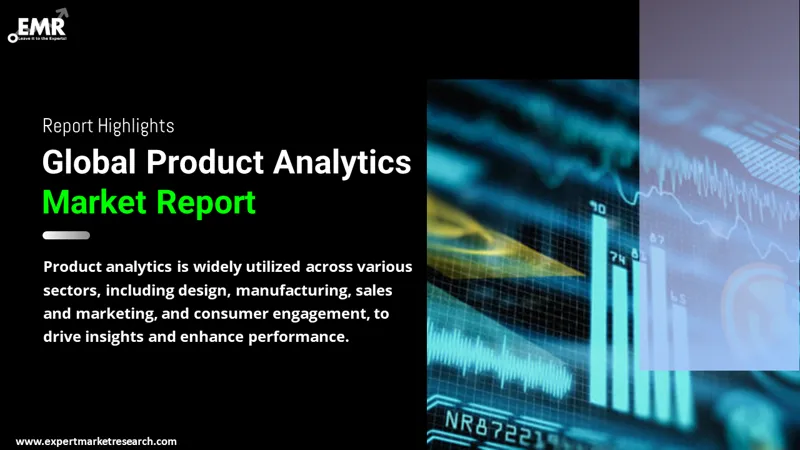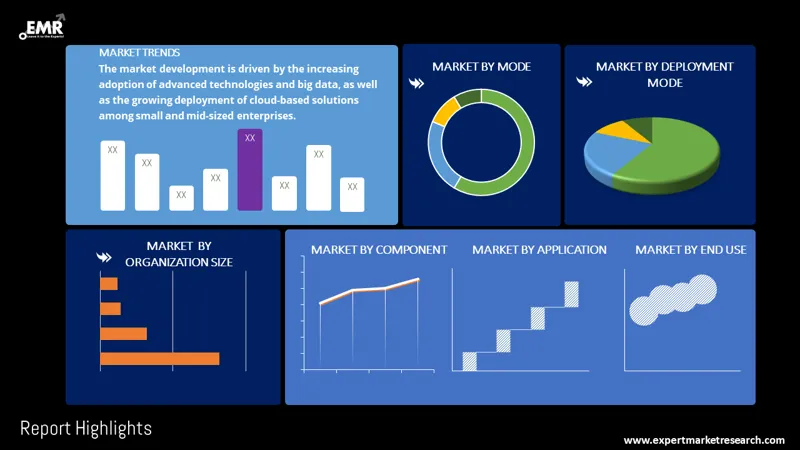
Consumer Insights
Uncover trends and behaviors shaping consumer choices today
Procurement Insights
Optimize your sourcing strategy with key market data
Industry Stats
Stay ahead with the latest trends and market analysis.
The global product analytics market attained a value of USD 12.03 Billion in 2025. The industry is further expected to grow in the forecast period of 2026-2035 at a CAGR of 15.10% to reach USD 49.09 Billion by 2035.
Base Year
Historical Period
Forecast Period
Compound Annual Growth Rate
15.1%
Value in USD Billion
2026-2035
*this image is indicative*
The industry is expanding due to the rising adoption of artificial intelligence. North America is expected to be the leading market due to the growing introduction of advanced technologies in the region.

Read more about this report - REQUEST FREE SAMPLE COPY IN PDF
The EMR’s report titled “Product Analytics Market Report and Forecast 2026-2035” offers a detailed analysis of the market based on the following segments:
Market Breakup by Mode
Market Breakup by Component
Market Breakup by Deployment Mode
Market Breakup by Organization Size
Market Breakup by Application
Market Breakup by End Use
Market Breakup by Region

Read more about this report - REQUEST FREE SAMPLE COPY IN PDF
The global product analytics market is being driven by the growing need of organisations for monitoring market competitiveness, globally. The industry is further aided by the high adoption of big data and advanced technologies. The increasing demand for cloud-based analytical solutions is fuelling the demand of the industry. The small and medium-sized enterprises segment is expected to grow at the fastest rate owing to the increased adoption of cloud-based solutions to minimise the maintenance cost of contracting professional staff. Based on end-use, retail and consumer goods is expected to witness a significant growth due to the growing need of suppliers for better understanding of consumer needs and attitudes. North America is anticipated to hold the largest share in the industry during the forecast period due to the presence of key vendors in the region, particularly in the US.
The report presents a detailed analysis of the following key players in the global product analytics market, looking into their capacity, competitive landscape, and latest developments like capacity expansions, plant turnarounds, and mergers and acquisitions:
The EMR report gives an in-depth insight into the industry by providing a SWOT analysis as well as an analysis of Porter’s five forces.




*While we strive to always give you current and accurate information, the numbers depicted on the website are indicative and may differ from the actual numbers in the main report. At Expert Market Research, we aim to bring you the latest insights and trends in the market. Using our analyses and forecasts, stakeholders can understand the market dynamics, navigate challenges, and capitalize on opportunities to make data-driven strategic decisions.*
Get in touch with us for a customized solution tailored to your unique requirements and save upto 35%!
The global product analytics market reached a value of USD 12.03 Billion in 2025.
The market is projected to grow at a CAGR of nearly 15.10% in the forecast period of 2026-2035.
The market is estimated to reach a value of about USD 49.09 Billion by 2035.
The major drivers of the market include rising disposable incomes, increasing population, rising need of organisations for monitoring market competitiveness, and the rising adoption of artificial intelligence.
The growing adoption of advanced technologies and big data and the increasing deployment of cloud-based solutions by small and mid-sized enterprises are key trends guiding the market development.
North America, Europe, the Asia Pacific, Latin America, and the Middle East and Africa are the leading regions in the market.
The major modes considered in the market report include tracking data and analysing data.
The leading components of the product are solutions and services.
The significant deployment modes of the product in the market are cloud and on-premises.
The several organisation sizes of product analytics considered in the market report are small and medium-sized enterprises and large enterprises.
The significant applications of product analytics are designers, manufacturers, sales and marketing professionals, and consumer engagement.
The various end-uses of product analytics in the market are automotive, retail and consumer goods, F&B manufacturing, machinery and industrial equipment manufacturing, healthcare and pharmaceuticals, and energy and utilities.
The key players in the market are Google LLC, International Business Machines Corporation, Amplitude, Salesforce.com, Inc., Mixpanel Inc., Piwik PRO GmbH, Heap, Inc., Pendo.io, Inc., Adobe Inc., Oracle Corporation, and Plytix.com ApS, among others.
Explore our key highlights of the report and gain a concise overview of key findings, trends, and actionable insights that will empower your strategic decisions.
| REPORT FEATURES | DETAILS |
| Base Year | 2025 |
| Historical Period | 2019-2025 |
| Forecast Period | 2026-2035 |
| Scope of the Report |
Historical and Forecast Trends, Industry Drivers and Constraints, Historical and Forecast Market Analysis by Segment:
|
| Breakup by Mode |
|
| Breakup by Component |
|
| Breakup by Deployment Mode |
|
| Breakup by Organization Size |
|
| Breakup by Application |
|
| Breakup by End Use |
|
| Breakup by Region |
|
| Market Dynamics |
|
| Competitive Landscape |
|
| Companies Covered |
|
| Report Price and Purchase Option | Explore our purchase options that are best suited to your resources and industry needs. |
| Delivery Format | Delivered as an attached PDF and Excel through email, with an option of receiving an editable PPT, according to the purchase option. |
Datasheet
One User
USD 2,499
USD 2,249
tax inclusive*
Single User License
One User
USD 3,999
USD 3,599
tax inclusive*
Five User License
Five User
USD 4,999
USD 4,249
tax inclusive*
Corporate License
Unlimited Users
USD 5,999
USD 5,099
tax inclusive*
*Please note that the prices mentioned below are starting prices for each bundle type. Kindly contact our team for further details.*
Flash Bundle
Small Business Bundle
Growth Bundle
Enterprise Bundle
*Please note that the prices mentioned below are starting prices for each bundle type. Kindly contact our team for further details.*
Flash Bundle
Number of Reports: 3
20%
tax inclusive*
Small Business Bundle
Number of Reports: 5
25%
tax inclusive*
Growth Bundle
Number of Reports: 8
30%
tax inclusive*
Enterprise Bundle
Number of Reports: 10
35%
tax inclusive*
How To Order

Select License Type
Choose the right license for your needs and access rights.

Click on ‘Buy Now’
Add the report to your cart with one click and proceed to register.

Select Mode of Payment
Choose a payment option for a secure checkout. You will be redirected accordingly.
Gain insights to stay ahead and seize opportunities.

Get insights & trends for a competitive edge.

Track prices with detailed trend reports.

Analyse trade data for supply chain insights.

Leverage cost reports for smart savings

Enhance supply chain with partnerships.

Connect For More Information
Our expert team of analysts will offer full support and resolve any queries regarding the report, before and after the purchase.
Our expert team of analysts will offer full support and resolve any queries regarding the report, before and after the purchase.
We employ meticulous research methods, blending advanced analytics and expert insights to deliver accurate, actionable industry intelligence, staying ahead of competitors.
Our skilled analysts offer unparalleled competitive advantage with detailed insights on current and emerging markets, ensuring your strategic edge.
We offer an in-depth yet simplified presentation of industry insights and analysis to meet your specific requirements effectively.
Share